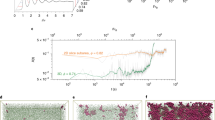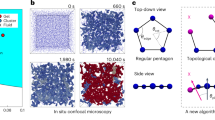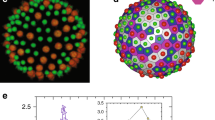Abstract
As a glass-forming liquid is cooled, the dynamics of its constituent particles changes from being liquid-like to more solid-like. The solidity of the resulting glassy material is believed to be due to a cage-formation process, whereby the motion of individual particles is increasingly constrained by neighbouring particles. This process begins at the temperature (or particle density) at which the glass-forming liquid first shows signs of glassy dynamics; however, the details of how the cages form remain unclear1,2,3,4. Here we study cage formation at the particle level in a two-dimensional colloidal suspension (a glass-forming liquid). We use focused lasers to perturb the suspension at the particle level and monitor the nonlinear dynamic response of the system using video microscopy. All observables that we consider respond non-monotonically as a function of the particle density, peaking at the density at which glassy dynamics is first observed. We identify this maximum response as being due to cage formation, quantified by the appearance of domains in which particles move in a cooperative manner. As the particle density increases further, these local domains become increasingly rigid and dominate the macroscale particle dynamics. This microscale rheological deformation approach demonstrates that cage formation in glass-forming liquids is directly related to the merging of such domains, and reveals the first step in the transformation of liquids to glassy materials1,5.
This is a preview of subscription content, access via your institution
Access options
Access Nature and 54 other Nature Portfolio journals
Get Nature+, our best-value online-access subscription
$29.99 / 30 days
cancel any time
Subscribe to this journal
Receive 51 print issues and online access
$199.00 per year
only $3.90 per issue
Buy this article
- Purchase on SpringerLink
- Instant access to full article PDF
Prices may be subject to local taxes which are calculated during checkout



Similar content being viewed by others
Data availability
The figures and videos that support the findings of this study are available at https://zenodo.org/record/3989982#.Xzv_cxFS8nQ.
Code availability
The code used is available from B.L.
References
Binder, K. & Kob, W. Glassy Materials and Disordered Solids: An Introduction to their Statistical Mechanics (World Scientific, 2011).
Weeks, E. & Weitz, D. Subdiffusion and the cage effect studied near the colloidal glass transition. Chem. Phys. 284, 361–367 (2002).
Sastry, S., Truskett, T. M., Debenedetti, P. G., Salvatore, T. & Stillinger, F. H. Free volume in the hard sphere liquid. Mol. Phys. 95, 289–297 (1998).
Pastore, R., Giuseppe, P., Antonio, S. & Pica Ciamarra, M. Cage size and jump precursors in glass-forming liquids: experiment and simulations. J. Phys. Chem. Lett. 8, 1562–1568 (2017).
Cavagna, A. Supercooled liquids for pedestrians. Phys. Rep. 476, 51–124 (2009).
van Megen, W. & Underwood, S. M. Glass transition in colloidal hard spheres: mode-coupling theory analysis. Phys. Rev. Lett. 70, 2766–2769 (1993).
Barrat, J.-L., Roux, J.-N. & Hansen, J.-P. Diffusion, viscosity and structural slowing down in soft sphere alloys near the kinetic glass transition. Chem. Phys. 149, 197–208 (1990).
Kob, W. & Andersen, H. C. Testing mode-coupling theory for a supercooled binary Lennard-Jones mixture I: the van Hove correlation function. Phys. Rev. E 51, 4626–4641 (1995).
Murray, C. A. & Grier, D. G. Video microscopy of monodisperse colloidal systems. Annu. Rev. Phys. Chem. 47, 421–462 (1996).
Weeks, E., Crocker, J., Levitt, A., Schofield, A. & Weitz, D. Three-dimensional direct imaging of structural relaxation near the colloidal glass transition. Science 287, 627–631 (2000).
Kegel, W. K. & van Blaaderen, A. Direct observation of dynamical heterogeneities in colloidal hard-sphere suspensions. Science 287, 290–293 (2000).
Li, B. et al. Breakdown of diffusivity–entropy scaling in colloidal glass-forming liquids. Commun. Phys. 1, 79 (2018).
Anderson, D. et al. Local elastic response measured near the colloidal glass transition. J. Chem. Phys. 138, 12A520 (2013).
Hunter, G. L. & Weeks, E. R. The physics of the colloidal glass transition. Rep. Prog. Phys. 75, 066501 (2012).
Nagamanasa, K. H., Gokhale, S., Sood, A. & Ganapathy, R. Direct measurements of growing amorphous order and non-monotonic dynamic correlations in a colloidal glass-former. Nat. Phys. 11, 403–408 (2015).
Buttinoni, I. et al. Direct observation of impact propagation and absorption in dense colloidal monolayers. Proc. Natl Acad. Sci. USA 114, 12150–12155 (2017).
Cash, C. E. et al. Local melting attracts grain boundaries in colloidal polycrystals. Phys. Rev. Lett. 120, 018002 (2018).
Lavergne, F. A., Curran, A., Aarts, D. G. & Dullens, R. P. Dislocation-controlled formation and kinetics of grain boundary loops in two-dimensional crystals. Proc. Natl Acad. Sci. USA 115, 6922 (2018).
Lozano, C., Gomez-Solano, J. R. & Bechinger, C. Active particles sense micromechanical properties of glasses. Nat. Mater. 18, 1118–1123 (2019).
Götze, W. Complex Dynamics of Glass-Forming Liquids: A Mode-Coupling Theory (Oxford Univ. Press, 2008).
Vivek, S., Kelleher, C. P., Chaikin, P. M. & Weeks, E. R. Long-wavelength fluctuations and the glass transition in two dimensions and three dimensions. Proc. Natl Acad. Sci. USA 114, 1850–1855 (2017).
Flenner, E. & Szamel, G. Viscoelastic shear stress relaxation in two-dimensional glass-forming liquids. Proc. Natl Acad. Sci. USA 116, 2015–2020 (2019).
Hansen, J.-P. & McDonald, I. R. Theory of Simple Liquids (Academic Press, 1986).
Schweizer, K. Dynamical fluctuation effects in glassy colloidal suspensions. Curr. Opin. Coll. Interf. Sci. 12, 297–306 (2007).
Kob, W., Donati, C., Plimpton, S. J., Poole, P. H. & Glotzer, S. C. Dynamical heterogeneities in a supercooled Lennard-Jones liquid. Phys. Rev. Lett. 79, 2827–2830 (1997).
Kob, W., Roldán-Vargas, S. & Berthier, L. Non-monotonic temperature evolution of dynamic correlations in glass-forming liquids. Nat. Phys. 8, 164–167 (2012).
Gazuz, I., Puertas, A., Voigtmann, T. & Fuchs, M. Active and nonlinear microrheology in dense colloidal suspensions. Phys. Rev. Lett. 102, 248302 (2009).
Gruber, M., Puertas, A. & Fuchs, M. Critical force in active microrheology. Phys. Rev. E 101, 012612 (2020).
Lerner, E. & Bouchbinder, E. A characteristic energy scale in glasses. J. Chem. Phys. 148, 214502 (2018).
Li, B., Xiao, X., Wang, S., Wen, W. & Wang, Z. Real-space mapping of the two-dimensional phase diagrams in attractive colloidal systems. Phys. Rev. X 9, 031032 (2019).
Yang, F., Wu, W., Chen, S. & Gan, W. The ionic strength dependent zeta potential at the surface of hexadecane droplets in water and the corresponding interfacial adsorption of surfactants. Soft Matter 13, 638–646 (2017).
Edmond, K. V., Nugent, C. R. & Weeks, E. R. Influence of confinement on dynamical heterogeneities in dense colloidal samples. Phys. Rev. E 85, 041401 (2012).
Ma, X. et al. Test of the universal scaling law of diffusion in colloidal monolayers. Phys. Rev. Lett. 110, 078302 (2013).
Eppmann, P., Prüger, B. & Gimsa, J. Particle characterization by AC electrokinetic phenomena: 2. Dielectrophoresis of latex particles measured by dielectrophoretic phase analysis light scattering (DPALS). Coll. Surf. A 149, 443–449 (1999).
Villadsen, N. et al. Pushing the limit: investigation of hydrodynamic forces on a trapped particle kicked by a laser pulse. Opt. Express 23, 13141–13152 (2015).
Zensen, C., Villadsen, N., Winterer, F., Keiding, S. & Lohmüller, T. Pushing nanoparticles with light – a femtonewton resolved measurement of optical scattering forces. APL Photon. 1, 026102 (2016).
Kurita, R. & Weeks, E. R. Glass transition of two-dimensional binary soft-disk mixtures with large size ratios. Phys. Rev. E 82, 041402 (2010).
Weysser, F. & Hajnal, D. Tests of mode-coupling theory in two dimensions. Phys. Rev. E 83, 041503 (2011).
Ediger, M. Spatially heterogeneous dynamics in supercooled liquids. Annu. Rev. Phys. Chem. 51, 99–128 (2000).
van Megen, W., Mortensen, T. C., Williams, S. R. & Müller, J. Measurement of the self-intermediate scattering function of suspensions of hard spherical particles near the glass transition. Phys. Rev. E 58, 6073–6085 (1998).
Brambilla, G. et al. Probing the equilibrium dynamics of colloidal hard spheres above the mode-coupling glass transition. Phys. Rev. Lett. 102, 085703 (2009).
Klix, C. L., Maret, G. & Keim, P. Discontinuous shear modulus determines the glass transition temperature. Phys. Rev. X 5, 041033 (2015).
Acknowledgements
We thank L. Cipelletti and M. D. Ediger for discussions. This study was supported by the Korean Institute for Basic Science (project code IBS-R020-D1) and grant ANR-15-CE30-0003-02. W.K. is senior member of the Institut Universitaire de France.
Author information
Authors and Affiliations
Contributions
B.L., W.K. and S.G. designed the research. B.L. and K.L. carried out the measurements. B.L. analysed the data. B.L., W.K. and S.G. wrote the paper.
Corresponding authors
Ethics declarations
Competing interests
The authors declare no competing interests.
Additional information
Peer review information Nature thanks George Petekidis, Eric Weeks and the other, anonymous, reviewer(s) for their contribution to the peer review of this work. Peer reviewer reports are available.
Publisher’s note Springer Nature remains neutral with regard to jurisdictional claims in published maps and institutional affiliations.
Extended data figures and tables
Extended Data Fig. 1 Details of laser-beam setup.
a, Bright-field image of a sample under a four-point laser beam designed to allow parallel accumulation of large amounts of statistics in the same experiment. The illuminated spots are sufficiently distant that the excitations are independent. Scale bar, 12 μm. b, Displacement as a function of time for four typical particles with different distances to the centre of the laser beam (ϕ = 0.35). To show the direct effect of the laser, we chose particles that do not collide with others during the whole excitation event. Dashed lines are guides to the eye. c, d, Nmax (c) and Rg (d) as a function of distance between the beam centre and mass centre of the particle closest to the laser spot (ϕ = 0.60, A = 99 mW). e, Brightness intensity profile across the laser spot for two beam powers (see legend). The curve for A = 0 shows the noise of the signal in the absence of a beam. f, The half-width of the intensity profile as a function of A. The dashed line is a guide to the eye. g, Displacement of an isolated particle that has been hit by a laser pulse with intensity A and duration 0.5 s (ϕ = 0.32). The dashed line is a linear fit.
Extended Data Fig. 2 Static and dynamic properties of the quiescent system.
a, The radial distribution function g(r) for samples with different ϕ (0.45, 0.52, 0.57, 0.60, 0.65 and 0.73). Inset, height of the first peak of g(r) as a function of ϕ. b, Mean squared displacement Δ2 as a function of time t, for samples with different ϕ. c, The first (logarithmic) derivative of the mean square displacement as a function of t, for samples with different ϕ. d, The van Hove function for ϕ = 0.60 at different times (see also Supplementary Videos 2–4). e, Intermediate scattering function Fs for samples with different ϕ. The wavevector is q = 2.2 μm−1. f, The non-Gaussian parameter α2 as a function of t for samples with different ϕ.
Extended Data Fig. 3 Influence of laser-pulse duration on excitation pattern.
a, A change in τα (defined as the time at which Fs in Extended Data Fig. 2e decays to 1/e) by a factor of two (indicated by the horizontal blue dashed lines) corresponds to a substantial change in the corresponding packing fraction ϕ (indicated by the vertical red dashed lines). b, Size of an excitation as a function of ϕ, for two laser durations (A = 99 mW). c, Variance of the Nmax as a function of ϕ.
Extended Data Fig. 4 The non-monotonic response of the system is independent of the laser intensity.
a, The average excitation size as a function of A. Dotted lines are linear fits. b, The variance of the excitation size as a function of A. Dotted lines are guides to the eye. c, Three-dimensional plot of the excitation size as a function of ϕ and A. The colour represents the variance of the excitation size.
Extended Data Fig. 5 Excitation patterns for different laser intensities.
a–c, Excitation patterns for A = 25 mW in a sample with ϕ = 0.58, 5 s after the laser has been turned off. The colour represents the displacement of the particles (see colour scale). The duration of the pulse was 0.5 s. The separation between two excitation events was around 20 s. Scale bars, 10 μm. d–f, Same as a–c, but for A = 59 mW. The white crosses indicate the position of the laser spot.
Supplementary information
Supplementary Video 1
Femtosecond laser pulse. Video showing how a femtosecond laser pulse hits a particle in a colloidal sample and sets up an excitation.
Supplementary Video 2
Excitation below the onset packing fraction. Video showing the displacement field (left panel) after a laser pulse hits the sample (right panel). Packing fraction is 0.50.
Supplementary Video 3
Excitation at the onset packing fraction. Video showing the displacement field (left panel) after a laser pulse hits the sample (right panel). Packing fraction is 0.60.
Supplementary Video 4
Excitation above the onset packing fraction. Video showing the displacement field (left panel) after a laser pulse hits the sample (right panel). Packing fraction is 0.70.
Rights and permissions
About this article
Cite this article
Li, B., Lou, K., Kob, W. et al. Anatomy of cage formation in a two-dimensional glass-forming liquid. Nature 587, 225–229 (2020). https://doi.org/10.1038/s41586-020-2869-5
Received:
Accepted:
Published:
Issue Date:
DOI: https://doi.org/10.1038/s41586-020-2869-5



